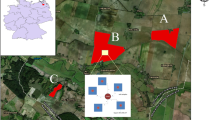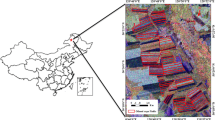Abstract
Crop aboveground biomass (AGB) is one of the most important indicators in diagnosing and monitoring agricultural ecosystems. AGB estimation not only closely relates to monitoring crop yield and production but also contributes to the research about the carbon cycle process and global climate change. In this study, the AGB of rice was estimated by vegetation indices (VIs) from optical data (GF-1) and polarization parameters (PPs) from radar data (RADARSAT-2) by best-fitting regression function first. Then, considering the different characteristics of these two types of remote sensing data, the vegetation indices and polarization parameters were combined to estimate the rice AGB. The results showed that all the selected vegetation indices and most of the polarization parameters were significantly correlated with the measured rice biomass; CIgreen and Anisotropy presented the best performance (R2 = 0.6123, RMSE = 0.4861 kg/m2 and R2 = 0.6543, RMSE = 0.5418 kg/m2, respectively). Compared with a single index or parameter, the new hybrid index significantly improves the biomass estimation: R2 = 0.7049; RMSE = 0.4849 kg/m2. A sensitivity analysis further revealed that combining optical vegetation index and microwave bands maintains the good prediction of AGB during the whole rice growth period. The study has proved the potential of retrieving rice AGB jointly using optical images and SAR data.






Similar content being viewed by others
References
Alebele Y, Zhang X, Wang W, Yang G, Yao X, Zheng H, Zhu Y, Cao W, Cheng T (2020) Estimation of canopy biomass components in paddy rice from combined optical and SAR data using multi-target Gaussian regressor stacking. Remote Sens 12(16):2564
Allain S, Ferro Fam L, Pottier E. A polarimetric classification fom polsar data using SERD/DERD parameters [-C //Proc of 6th European Conference on Synthetic Aperture Radar. Dres den, Germany: VDE Verlag, 2006.
Bai DN, Jiao ZT, Dong YD et al (2017) Analysis of the sensitivity of anisotropic flat index to vegetation parameters based on two-layer canopy reflectance model. J Remote Sens 21(1):1–11
Bao YS, Gao W, Gao ZQ (2009) Estimation of winter wheat biomass based on remote sensing data at various spatial and spectral resolutions. Front Earth Sci 3:118–128
Behera MD, Ghosh SM (2021) Aboveground biomass estimates of tropical mangrove forest using sentinel-1 sar coherence data - the superiority of deep learning over semi-empirical model. Comput. Geosci 150: 104737
Chan E, Fung T, Wong F (2021) Estimating above-ground biomass of subtropical forest using airborne lidar in HongKong. Sci Rep 11(1):1–14
Chen JM (1996) Evaluation of vegetation indices and a modified simple ratio for boreal applications. Can J Remote Sens 22(3):229–242
Cloude SR (2009) Polarisation: applications in remote sensing. Oxford University Press, Oxford, UK
Cloude SR, Pottier E (1997) An entropy based classification scheme for land applications of polarimetric SAR. IEEE Trans Geosci Remote Sens 35:68–78
Colorado JD, Calderon F, Mendez D et al (2020) A Novel NIR-Image Segmentation Method for the Precise Estimation of above-Ground Biomass in Rice Crops PLOS ONE 15(10):1–19
Freeman A, Durden SL (1998) A three-component scattering model for polarimetric SAR data. IEEE Trans Geosci Remote Sens 36(3):963–973
Fu HY, Wang CF, Cui GX, She W, Zhao L (2021) Ramie yield estimation based on UAV RGB images. Sens 21(2):669
Gao S, Niu Z, Huang N, Hou X (2013) Estimating the leaf area index, height and biomass of maize using HJ-1 and RADARSAT-2. Int J Appl Earth Obs 24:1–8
Gitelson AA (2004) Wide dynamic range vegetation index for remote quantification of biophysical characteristics of vegetation. J Plant Physiol 161(2):165–173
Gitelson AA, Merzlyak MN (1997) Remote estimation of chlorophyll content in higher plant leaves. Int J Remote Sens 18(12):2691–2697
Gitelson AA, Vina A, Ciganda V, Rundquist DC, Arkebauer TJ (2005) Remote estimation of canopy chlorophyll content in crops. Geophys Res Lett 32(8).
Haboudanea D, Miller JR, Pattey E, Zarco-Tejada PJ, Strachan IB (2004) Hyperspectral vegetation indices and novel algorithms for predicting green LAI of crop canopies: modeling and validation in the context of precision agriculture. Remote Sens Environ 90:337–352
Huete A, Didan K, Miura T, Rodriguez EP, Gao X, Ferreira LG (2002) Overview of the radiometric and biophysical performance of the MODIS vegetation indices. Remote Sens Environ 83(1–2):195–213
Jia MQ, Tong L, Chen Y, Zhang Y (2013) Rice biomass retrieval from multitemporal ground-based scatterometer data and RADARSAT-2 images using neural networks. J Appl Remote Sens 7(1): 073509
Jiang Z, Huete A, Didan K, Miura T (2008) Development of a two-band enhanced vegetation index without a blue band. Remote Sens Environ 112(10):3833–3845
Jiao Z, Li X, Wang J, Zhang H (2011) Assessment of MODIS BRDF shape indicators. J Remote Sens 15(3):432–456
Jin XL, Yang GJ, Xu XG et al (2015) Combined multi-temporal optical and radar parameters for estimating LAI and biomass in winter wheat using HJ and RADARSAT-2 data. Remote Sens 7(10):13251–13272
Jordan CF (1969) Derivation of leaf area index from quality of light in the forest floor. Ecol 50(4):663–666
Kross A, Mcnairn H, Lapen D, Sunohara M, Champagne C (2015) Assessment of RapidEye vegetation indices for estimation of leaf area index and biomass in corn and soybean crops. Int J Appl Earth Obs 34:235–248
Li MY, Liu TX, Luo YY, Duan LM, Ma L, Wang YX, Zhang JY, Zhou YJ, Yang Y, Chen ZX (2021) Fractional vegetation coverage downscaling inversion method based on land remote-sensing satellite (System, Landsat-8) and polarization decomposition of RADARSAT-2. Int J Remote Sens 42(9):3255–3276
Mansaray LR, Kanu AS, Yang L, Huang J, Wang F (2020a) Evaluation of machine learning models for rice dry biomass estimation and mapping using quad-source optical imagery. Gisci Remote Sens 57(6):785–796
Mansaray, LR, Zhang K, Kanu AS (2020b) Dry biomass estimation of paddy rice with Sentinel-1A satellite data using machine learning regression algorithms. Comput Electron Agr 176: 105674
Meng B, Yi S, Liang T, Yin J, Sun Y (2020) Modeling alpine grassland above ground biomass based on remote sensing data and machine learning algorithm: a case study in the east of Tibetan Plateau, China. IEEE J Sel Top Appl Earth Obs Remote Sens 13:2986–2995
Rouse JW, Haas RH, Schell JA (1974) Deering DW (1973) Monitoring vegetation systems in the Great Plains with ERTS. NASA Spec Publ 351:309
Sims DA, Gamon JA (2002) Relationships between leaf pigment content and spectral reflectance across a wide range of species, leaf structures and developmental stages. Remote Sens Environ 81(2–3):337–354
Tan LF, Chen Y, Jia MQ, Tong L, Li X, He L (2015) Rice biomass retrieval from advanced synthetic aperture radar image based on radar backscattering measurement. J Appl Remote Sens 9(1): 097091
Yang YJ, Huang Y, Tian QJ, Wang L, Yang RR (2015) The extraction model of paddy rice information based on GF-1 satellite WFV images. Spectrosc Spectral Anal 35(11):3255
Zhang LJ, Cheng QM, Li CM (2015) Improved model for estimating the biomass of populus euphratica forest using the integration of spectral and textural features from the Chinese high-resolution remote sensing satellite GaoFen-1. J Appl Remote Sens 9(1): 096010
Zhang XQ, Liu XN, Tan Z (2012) Rice biomass estimation based on full-polarization RADARSAT-2 data. Res Agric Modernization 33(2):249–252
Zhang Y, Yang B, Liu X, Wang C (2017) Estimation of rice grain yield from dual-polarization RADARSAT-2 SAR data by integrating a rice canopy scattering model and a genetic algorithm. Int J Appl Earth Obs Geoinf 57:75–85
Acknowledgements
We would like to thank the anonymous reviewers whose useful comments will improve the paper.
Funding
This research was supported by the department of housing and urban rural development of Jiangsu Province project (No. 2019ZD001112) and Foundation of Jiangsu Educational Committee (No. 20KJD170006).
Author information
Authors and Affiliations
Contributions
Xueliang Feng was responsible for the implementation of the method used to estimate the AGB and for data preparation, processing, and writing of the manuscript. Le Tang was responsible for the research design and analysis. Minhui Xu edited the figures and tables in the manuscript.
Corresponding author
Ethics declarations
Conflict of interest
The authors declare no competing interests.
Additional information
Responsible Editor: Haroun Chenchouni
Rights and permissions
About this article
Cite this article
Feng, X., Tang, L. & Xu, M. Estimating the biomass of rice by combining GF-1 and RADARSAT-2 data. Arab J Geosci 14, 2124 (2021). https://doi.org/10.1007/s12517-021-08545-7
Received:
Accepted:
Published:
DOI: https://doi.org/10.1007/s12517-021-08545-7




